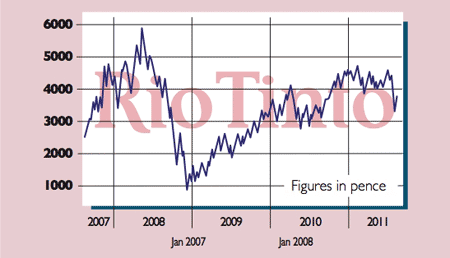
What is Rio Tinto?
Rio Tinto is one of the world’s largest mining companies. Its operations are split into five main product groups: aluminium, copper, diamonds and minerals, energy (coal and uranium) and iron ore. Although the company has operations in Europe, South America and Africa, most of its assets are in Australia and North America. Profits are dominated by its iron-ore operations, which accounted for two-thirds of net earnings in 2010.
What is the company’s history?
Rio Tinto was formed in 1873 to reopen ancient copper mines beside the river Tinto in southern Spain. The Zinc Corporation, on the other hand, was set up in Australia in 1905. In 1962, the UK operations of Rio Tinto and Consolidated Zinc merged to form Rio Tinto Zinc (RTZ). At the same time, the Australian interests of both companies were merged to form ConZinc Rio Tinto of Australia (CRA Ltd). In 1997, both companies came together under the Rio Tinto name. The $38.1bn purchase of Alcan Inc in 2007 made Rio Tinto the world’s largest aluminium producer.
Who runs Rio Tinto?
Tom Albanese has been CEO since 2007, having joined the company in 1993. He was previously CEO of the group’s copper operations and head of the exploration division. His total pay in 2010 was $2.9m. Former Richemont finance director Jan du Plessis is chairman, while Guy Elliot has been finance director since 2002.
How is trading?
First-half results saw record net income of $7.8bn – an increase of 35%. Although production volumes were lower, strong demand from Asia saw higher prices boost profits. Iron ore dominates the group’s profits, with earnings before interest, tax, depreciation and amortisation (EBITDA) up 43.7% to $9.6bn. Aluminium EBITDA increased by 9.1% to $1.4bn and copper by 15.7% to $2.2bn. Energy and diamonds’ profits were flat. The interim dividend was increased by 20% to 54 cents per share.
What’s the outlook for Rio Tinto?
In the medium term, Rio expects growth from major new projects in iron ore, copper and coking coal. However, profits are highly geared to commodity prices and are therefore vulnerable to economic turmoil in Europe and the USA. Cost inflation is a major issue going forward, while movements in exchange rates can have an adverse impact. Rio continues to generate decent free cash flow that should facilitate further dividend increases.
The analysts
Of the 31 analysts surveyed by Bloomberg, 27 say “buy”, two “hold” and two “sell”. The average price target is 5,367p – 45% above the current price. Most bullish is JP Morgan with a 6,300p price target. Alpha Value is most bearish, with a 3,663p target. Our view: despite trading on 6.4 times prospective earnings, we are wary of Rio’s high fixed operating costs in a weakening economic environment. Commodity exposure via ETFs may be a better route.
The numbers
Stockmarket code: RIO
Share price: 3,694p
Market cap £54.6bn
Net assets (June 2011): $69.3bn
Net debt (June 2011): $8.6bn
P/E (current year estimate): 6.4
Yield (prospective): 1.9%
Directors’ dealings
There have been no major purchases during the last six months. Tom Albanese sold 10,302 shares on 21 February; Guy Elliott sold 7,097 shares on 11 March, as shown in the chart . Executive directors are expected to own twice their base pay in shares within two years of appointment. Other members of the executive committee have five years to build their stakes, as shown in the table.
Director and shares held
T Albanese: 237,095
G Elliott: 96,477
J Cote: 10,840
A Harding*: 11,293
H Kenyon-Slaney: 18,722
S Walsh*: 46,950
D Ritchie*: 27,891
*in Australian-listed Rio Tinto Ltd
Source: 2010 Annual Report